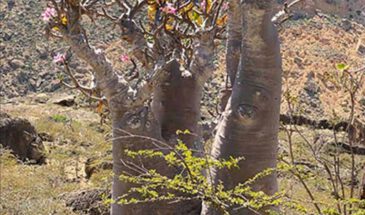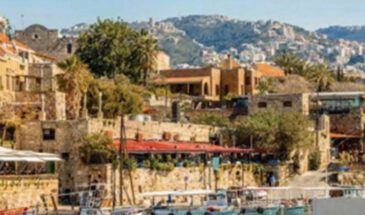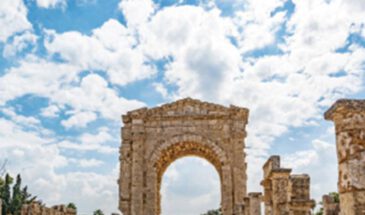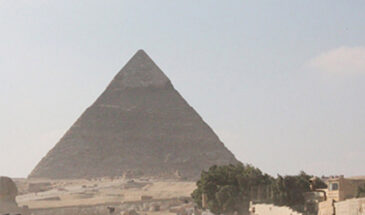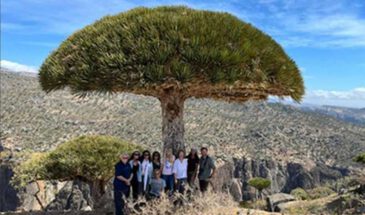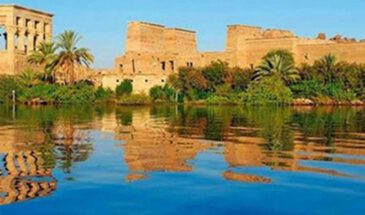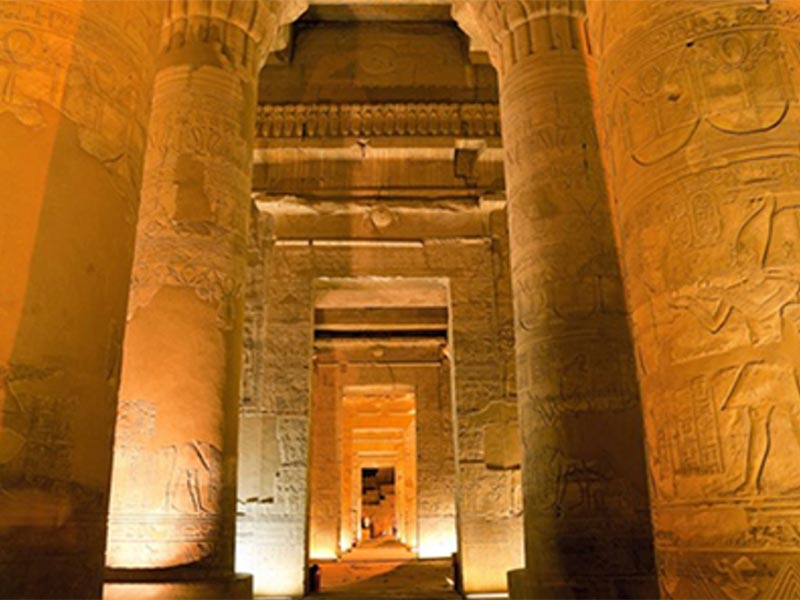- Overview
- Trip Outline
- Trip Includes
- Trip Excludes
- Gallery
- Booking
- FAQ
Sometimes you can’t decide and just want EVERYTHING:
WOW – here you can combine the highlights of three extraordinary countries worth seeing.
Egypt is regarded as a key player in the Middle East and Africa region.
We think, no traveler can avoid having been close to the Pharaos at least once in his life.
And we bring them to life - the Pyramids, the Sphinx, the Temples at Aswan and Luxor, as well as snorkeling paradises in the Red Sea.
Get the main attractions of Egypt all in one - Live life - Egypt!
If there’s one Middle Eastern country that is truly distinctive from other countries in the region, it has to be Lebanon.
It is an incredible tourist destination with its fascinating historical landmarks, pristine beaches, delicious cuisine, stellar night life and picturesque mountains. The country truly offers something for everyone’s taste.
Visitors can take in Phoenician ruins, Greek and Roman temples, medieval Arab cities, and a vibrant modern culture featuring some of the best food, music, and coffee culture in the world.
Insider tip for nature lovers and travel enthusiasts:
Socotra – a kind of modern Garden of Eden, a secret world filled with trees of knowledge and life – unique species with mythical names such as Dragons Blood or Desert Rose. Socotra is a botanists paradise.
It is the last place on planet Earth where no species that we know has gone extinct in the last 100 years. In recognition of it’s distinct plant and animal life, the archipelago was designated a UNESCO Word Heritage Site in 2008.
The Island stands isolated between the Guardafui Channel and the Arabian Sea and is often described as the Galapagos of the Indian Ocean.
Don’t worry about safety reasons – our travel experts take care about a safe journey.
Egypt
Day 1: Airport - Hotel (Wednesday)
Arrival and check-in to your hotel located in a quiet suburb of Maadi (Cairo). Time to explore the cafes and restaurants in the surroundings. In the evening general information's about the trip by your tour guide.
Overnight Pearl Hotel or similar.
Day 2: Egyptian Museum - Pyramdis - Sphinx (Thursday)
Escorted tour to visit:
The Egyptian Museum in Tahrir Square (the revolution and strikes at the 25th of Jan 2011 centered here), is still the main museum with a huge collection of ancient Egyptian antiquities including partly Tut Ankh Amoun famous treasures.
The Egyptian Museum is the oldest archaeological museum in the Middle East, and houses the largest collection of Pharaonic antiquities in the world. The museum displays an extensive collection spanning from the Predynastic Period to the Greco-Roman Era.
The architect of the building was selected through an international competition in 1895, which was the first of its kind, and was won by the French architect, Marcel Dourgnon. The museum was inaugurated in 1902 by Khedive Abbas Helmy II, and has become a historic landmark in downtown Cairo, and home to some of the world’s most magnificent ancient masterpieces.
Head afterward to visit the three Great Pyramids & Sphinx, Ride a camel, take some pictures and enjoy the area. According to traffic the order may change.
10 facts about the Sphinx:
- It Is Based on the Egyptian Mythological Creature of the Same Name
- It Is the World's Oldest Monumental Sculpture
- It Is the Largest Monolith Statue on Earth
- Thutmose IV Supposedly Rediscovered It After Falling Asleep on It
- It Took Three Years to Create
- It Is Composed of (Mostly) One Single Slab of Limestone
- It Used to Be Quite Colorful
- No One Knows Why Its Nose Is Missing
- It Once Sported a Beard
- It Was Most Recently Restored in 1988
Overnight in Cairo – Pearl Hotel Maadi or similar. (B)
Day 3: Cairo – Aswan (Nile cruise) (Friday)
Check out and transfer to Cairo Airport. Arrive at Aswan Airport and transfer to the dock to embark on your Nile Cruise.
Aswan, Egypt, is known for the remarkable preservation of its ancient archaeological sites. But beyond the otherworldly temples and rich history, Aswan is a city of open-air marketplaces, felucca cruises, and tranquil views.
Dinner & overnight onboard the cruise in Aswan. Overnight on the boat. Nile cruises offer a wide range to let you explore Egypt to the full. Tourists can have a wonderful time on our world-class Nile cruise; enjoying the exceptional ambiance & relishing our authentic Egyptian and international cuisine.
Overnight on M/S Cruise or similar (B/L/D)
Day 4: Aswan - Kom Ombo - Edfu (Nile Cruise) (Saturday)
Breakfast on board . Proceed with visiting the Temple of Philae.280 BCE. Built during the reign of Ptolemy II (Egypt's Greco-Roman Period), the Temple of Isis at Philae is dedicated to Isis, Osiris, and Horus. The temple walls contain scenes from Egyptian mythology of Isis bringing Osiris back to life, giving birth to Horus, and mummifying Osiris after his death.
Sail to Kom Ombo and visit the temple, dedicated to Gods Sobek and Haroeris.
In Kom Ombo there is a rare engraved image of what is thought to be the first representation of medical instruments for performing surgery, including scalpels, curettes, forceps, dilator, scissors and medicine bottles dating from the days of Roman Egypt.
Sail to the temple of Edfu. Arrive at Edfu & overnight on board the cruise in Edfu.
Overnight on the Cruise or similar. (B/L/D)
Day 5: Edfu - Luxor (Nile Cruise) (Sunday)
Breakfast on board. Visit the Temple of Edfu, dedicated to the God Horus
The Edfu temple represents a lost art that showcases the true spirit of the ancient Egyptian civilization from the perspective of the Ptolemaic dynasty.1
Sail to Esna Lock. Have lunch. Sail to Luxor and visit the East Bank, Karnak, and Luxor Temples. Return to the boat in Luxor.
Overnight on M/S Cruise or similar (B/L/D)
Day 6: Luxor - Vally of the Kings - Cairo (Sleeper train) (Monday)
Breakfast on board the cruise. Disembark from the Cruise Ship. Visit West Bank: the valley of the kings, the temple of Queen Hatshepsut at El Deir El Bahari.
The Nile river splits Luxor into two parts: The East Bank and the West Bank. The East bank is the location of Luxor town. Here you find Luxor temple and Karnak temple. The Westbank of Luxor is where the ancient Egyptians buried the dead. Each night, the sun sets on the Westbank, so this became the necropolis, the area that is filled with the tombs and mortuary temples.
Overnight train back to Cairo. (B/D)
Day 7: Cairo - Airport - (flight) Beirut (Tuesday) (LEBANON)
Arrival in the morning – transfer to hotel – Pearl Hotel or similar
Day at leisure
Optional: Pick up from the hotel. Escorted tour to visit Islamic Cairo
Tucked away amid the modern urban area of Cairo lies one of the world's oldest Islamic cities, with its famous mosques, madrasas, hammams and fountains. Founded in the 10th century, it became the new centre of the Islamic world, reaching its golden age in the 14th century.
Sultan Refae Mosque, Sultan Hassan Mosque, Ibn Toulon Mosque & Citadel of Saladin. If time allows optional visit to Citadel of Saladin.
Late afternoon: Airport transfer - Flight to Beirut
Our tour guide will be waiting for you on arrival and will assist with Check Inn at your hotel. Feel some first vibes of Beirut at night.
Overnight in Beirut in Hotel or similar (B)
Day 8: Beirut - Batroon - Beirut (Wednesday)
We start early heading towards Batroun. It is is one of the most beautiful coastal cities in Lebanon and one of the oldest in the world. It has history, architecture, churches, beaches, bars, seafood, lemonade, and more.
Take a walk through the streets of Batroun and enjoy the beautiful architecture of the city! Back to Beirut.
Overnight Hotel Beirut or similar (B)
Day 9: Beirut - Bcharre - Cedars of God - Batroon (Thursday)
After this visit our way leads to Bcharre. Perched atop the stunning Qadisha Valley, Bcharre is one of those idyllic mountain villages that looks like it’s come straight out of storybook.
Bcharre is the hometown of the famous Lebanese poet Khalil Gibran (1883-1931), the third best-selling poet of all time, following only Shakespeare and Lao-Tzu. Though he spent much of his life in the United States, a lot of Gibran’s poetry and artwork reflects his upbringing in Lebanon’s mountains. The museum itself is a 19th-century monastery that was cut straight into the rock, giving it an extra mountainous feel. It was Gibran’s dying wish to be buried in the monastery and have it
converted into a museum, which we will visit.
But there is still another highlight to come: The UNESCO Heritage site – the Cedars of God. On the Lebanese flag the cedar stands eternally tall. It is one of the most defining features of Lebanon`s culture. It is not only today that cedars take on a big role in putting Lebanon on the global map. The trees are first mentioned in the Epic of Gilgamesh; and over the years, many peoples have made use of cedar wood provided by the forest. Have a walk in the forest and see yourself.
Finally on our way back we will have a stop-over at the Monastery of Saint Anthony situated at a height of 950 meters above sea level in the celebrated Valley of Qozhaya,. Centuries ago, it was a pioneering place in book-printing and till today it is a place of pilgrimage for Christians and Muslims who come from all regions seeking cures, divine grace and peace of mind.
We end a long day of intense impressions back in Batroun, where you can enjoy the lively evening atmosphere.
Overnight Hotel in Batroun or similar. (B)
Day 10: Batroon - Beirut - Airport (flight) - Cairo (Friday)
Enjoy the morning In Batroun at the beach or walking around or just relaxing.
Check out at the hotel at 3 pm and transfer to the Airport in Beirut.
Flight to Cairo –
Overnight hotel – Pearl Hotel Maadi or similar. (B)
Day 11: Cairo (Saturday)
Enjoy a free day to simply soak up Cairo’s lively atmosphere or shop for suitable souvenirs. We would be happy to advise you.
Overnight Pearl Hotel Maadi or similar. (B)
SOCOTRA
Day 12: Cairo - Airport ( Flight) - Adan (Sunday)
Either you look back on your impressions of Lebanon and prepare for the next leg of your journey, or you visit the Museum of Civilization (Optional: 3 h).
National Museum of Egyptian Civilization (NMEC) is located in Fustat, the first Egyptian capital after the Arab Islamic conquest, so it was a logical choice for the museum site, as the area is located at the crossroads of Egyptian history, and it includes many Coptic churches and monasteries, the Coptic Museum,
the Ibn Ezra Temple, and the first mosque in Egypt, the Amr Ibn Al-Aas Mosque. The Citadel of Saladin can also be seen from the museum's outdoor spaces, designed to emphasize the unique location overlooking Lake Ain El-Sira, the last natural lake in Cairo.
The museum partially opened in 2021, and will display a collection of 50.000 artifacts, presenting Egyptian Civilization from prehistoric times to the present day.
The permanent collection is divided into two separate regions, one chronological the other thematic. the chronological area will be the following archaic: Archaic, pharaonic, Greco-Roman, Coptic, Medieval, Islamic, modern and contemporary. The thematic areas will be the following: Down of Civilization, the Nile, writing, state and Society, Material culture, Beliefs and thinking and the gallery of royal mummies.
Airport transfer
This will be a night flight- Transit in Adan (B)
Day 13: Airport Adan (flight) - Hadibu (Monday)
Upon your arrival at Socotra Airport, we will pick you up and transport you to a local restaurant for lunch in Hadibu, the island's capital. After lunch, we will drive you on a trip to Ayhaft Canyon National Park. In the canyon (wadi), we will enjoy large fresh pools where we can swim or soak. There will be tamarind trees, cucumber trees, and a wide variety of birds such as Socotra sparrow, Socotra sunbird, and both Socotra and Somali starlings. Ayhaft is a natural nursery due to its abundant endemic trees, plants, and birds. In the late afternoon, we can spend time with local villagers by visiting them in their humble houses, having tea, and interacting with Them.
Overnight In Ayhaft. (L/D)
Day 14: Qalansyia - Detwah Lagoon - The Golden Beach of Shuab (Tuesday)
After an early breakfast, we will explore the western part of Socotra. The first place that we will visit will be Qalansiya, a traditional fishing village. From there, we will make a boat trip to Shuab. We may see spinner dolphins and interesting rock formations during this boat ride. We will have time to swim, relax and enjoy this pristine place with its crystal clear water and white sand beach. After returning to Qalansiya, we will go
first to the viewpoint of Detwah Lagoon, a marine protected area renowned for its magical landscapes. Later, we will enjoy swimming in the lagoon's crystal waters or its pools and relax on its paradise white sand beach.
Overnight at Detwah campsite. (B/L/D)
Day 15: Dixsam Plateau - Derhur Canyon - Fermhin Forest (Wednesday)
After breakfast, we will go to Dixam Plateau. We will stop at Shebahon Viewpoint, which is located 700 m above sea level. The entire area is famous for numerous species of Socotra endemic plants, such as the Dragon's blood tree (dracaena cinnabar). From this viewpoint, we will also see the magnificent view of Dirhur Canyon. This canyon is famous for its breathtaking landscape and stunning rock formations. From the plateau, we will descend by car into the Derhur Canyon, lined with date palms, and you can swim in several clear lakes. After lunch, we will take a short drive to the isolated plateau of forest Fermhin, which is enclosed by deep canyons. Nowhere else in the world can you find Dragon's blood trees (Dracaena cinnabari) in such concentration as here. The characteristic appearance of this monocot plant and the age of most of them will captivate you. The Dragon's Blood tree (Dracaena cinnabari) is a symbol of the island; it grows to a height of 10 meters, and with its broad crown and shape, it resembles an umbrella or a gigantic mushroom. The precious Dragon's blood, or red sap, is literally a treasure. It has potent medicinal effects, and its use is also in demand in the cosmetic industry. You can buy this treasure in small quantities from the local families and try the beneficial effects - Dragon's Blood!
Dinner and overnight at Fermhin forest (B/L/D)
Day 16: Aomq sandy beach - Dagub Cave - Hayf and Zahaq dunes (Thursday)
If you wake up early in the morning, you can once again enjoy a short walk in the surroundings of the unique Fermhin forest. After breakfast, we will head to the less populated southern coast of Socotra to the beautiful turquoise-blue Indian Ocean and a place of endless white sand beaches.
A relaxing afternoon awaits you; you can rest in the shade of palm trees or fully enjoy swimming, sunbathing, and exploring the surroundings. At sunset, we will visit the beautiful sand dunes near the village of Hayf. A beautiful place that evokes a
sense of calm is incredibly photogenic. Depending on the time, we will visit the Dagub cave today or tomorrow morning on our way inland. At the entrance to the cave, the most valuable item of the dry south coast – pure water – flows down the impressive stalactite and stalagmite formations. A number of animals find refuge in the cave, especially bats and stories. It is possible to drive directly to the cave. Lunch/Dinner
Overnight at Aomq campsite. (B/L/D)
Day 17: Wadi Defarhu - Dihamari Marine Protected Area (Friday)
Today, we travel from the south of the island towards the north, crossing Wadi Defarhu, where we can spot traditional villages, date palms, natural freshwater pools at the bottom of the valley, and desert rose trees clinging to the canyon walls. After lunch, we will drive to the nearby Dihamri marine protected area. It boasts one of the richest coral reefs on the Socotra. You can relax on the beach in palm leaf huts and swim and snorkel in Dihamri Bay. Snorkeling gear can be hired there. Marine species you will see underwater include Parrotfish, Moray eel, Rays, and Sea urchins; if you are lucky, you will meet turtles. Divers can also use the services of Dihamri Diving Center and go for a dive in Dihamri or another of the superb diving spots of Socotra.
Overnight at Dihamri campsite. (B/L/D)
Day 18: Homhil Protected Area - stopover at Qaria lagoon - Wadi Kalisan (Saturday)
Today we make our way to Kalesan Canyon, taking in the fabulous sceneries of deep ravines and plains along the way. We will stop at Qaria Lagoon en route. Qaria lagoon is the largest lagoon on the island, and you can hopefully see Flamingos, Herons, and Greenshank, amongst others. Once at Kalesan, we can hike down to the canyon, where you can enjoy a big swimming pool and back for a picnic lunch at the place where the car is waiting for us.
After lunch, transfer to Homhil plateau - a fantastic place on the northeastern tip of the island with a large concentration of Dragon's blood trees (Dracaena cinnabari), desert roses, and frankincense trees. In addition to exceptional plants, the biggest attraction on the Homhil plateau is also the infinity pool. It is a natural lake located on the edge of a rock ledge and fed by several small streams. You can swim here, observe freshwater crabs and at the same time enjoy the fascinating view of the Arabian Sea.
overnight at Homhil campsite. (B/L/D)
Day 19: Hoq Cave - Arher freshwater creek and beach (Sunday)
After an early breakfast, we will go to Terbak village to visit Hoq Cave, known as well as Treasure Cave. The oldest traces of settlement on the island were found during archaeological research. In addition, wooden tablets in Aramaic were discovered dating back to 258 AD – the time Christians inhabited the island. We will go on a 1.5-hour hike up to the cave entrance and spend 1 hour inside. This largest cave on the island is 3.2 km deep. The cave is also famous for its unique dripstone forms, stalagmites and stalactites, and water reservoirs. , Afterward, we will go to, Arher, where there is a beautiful long beach, the most amazing white sand, and crystal clear blue waters with sand dunes that blend into the ocean. The highest dunes on the island. Time for a swim in the sea and relax on Arher beach. A small freshwater stream feeds into the ocean, where you can have a natural bath. Next, we will go to the island's eastern end to Ras Erisel – the meeting point of the Arabian Sea and the Indian Ocean.
Overnight camping at Arher. (B/L/D)
Day 20: Hadibu - (flight) - Adan - (flight) - Cairo (Monday)
If you wake up early in the morning, you can once again enjoy a short swim in the Arher long sandy beach and then take a bath in the freshwater stream. Breakfast will be at 7.30 and leaving the spot at 8.30 towards Socotra airport. On the way to the airport, we can stop at a heritage and souvenir shop run by Socotri women to support local Socotri women and enhance their income and livelihood.
Flight back to Cairo.
Overnight Pearl Hotel or similar. (B)
Day 21: Cairo - Airport (Tuesday)
After breakfast Airport transfer to Cairo International Airport (B)
- Private Tour
- Flight - Cairo/Beirut/Cairo
- Flight - Cairo/Adan/Hadibu/ Adan/Cairo
- Flight - Cairo/Aswan
- Accommodations 19hotels/Nile Cruise/Sleeper train/Camping
- Visa fee for Socotra
- meals: 19 B/ 9 L/ 8 D
- Sleeper train - Luxor/Cairo
- all transfers
- Program like mentioned above
- All park fees included
- International flights
- Visa fees (except Socotra)
- Travel insurance and all kind of insurances.
- Meals and drinks not mentioned.
- Tips for guide, drivers...
- Anything that is not mentioned in the program.
- Airport departure tax if any
No Details Found



